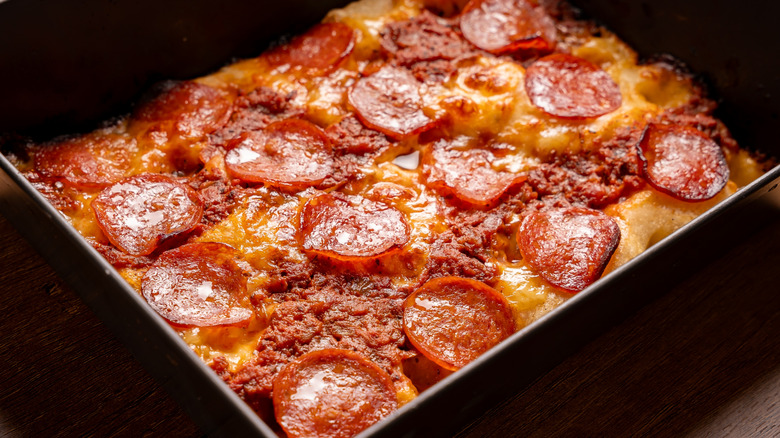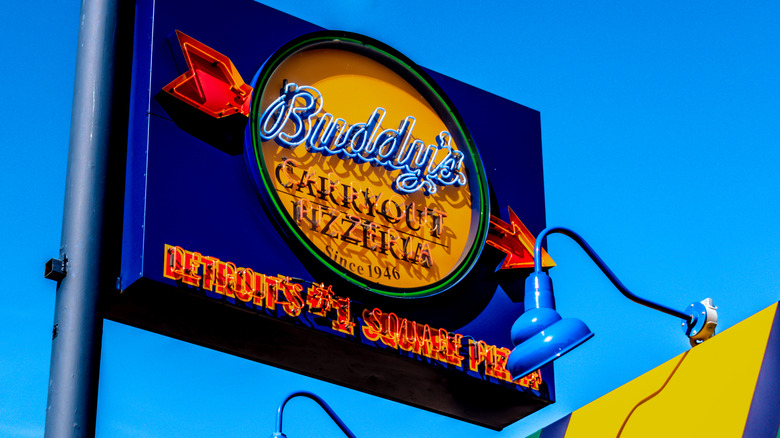Are Detroit-Style And Sicilian Pizza The Same Thing?
If you take a glance at a Detroit-style pizza (pictured above) and a Sicilian pizza, you'll likely notice a few similarities, but take note: The two pizzas are definitely not the same thing. Perhaps the most obvious difference is their origins, since those are right there in the names: One hails from Detroit, Michigan, and the other is associated with the Italian island of Sicily.
But beyond these pizzas' birthplaces, there are other important differences. While both pizzas are known for having quite a thick base and a fairly similar dough, the pans for Detroit-style are also fairly unique, even if both pizza styles share a similar rectangular shape. This is linked to Detroit's history as a car manufacturing city. Perhaps the biggest difference is the toppings, both in terms of what's put on there (especially the type of cheese used) and how the toppings are arranged. It's important to note that there are a couple of versions of Sicilian pizza, too — the kind you'll find in Sicily, and the kind that Sicilian immigrants brought to America, which has since evolved into a slightly different style. Here's what you should know.
Detroit-style pizza has brick cheese with sauce on top
Detroit-style pizza is often referred to as being square, although in reality, it's typically a rectangle. It's cooked in industrial pans that originated from Detroit's numerous factories and were used to carry around bolts and other small items, although those pans are not so easy to source anymore, so they're arguably not an absolute requirement for present-day Detroit-style pizza.
A Detroit-style pizza usually has quite a thick base, although the texture is light and spongy, as the dough is double proofed, making it quite airy. It's often compared to focaccia. In this sense, Detroit pies are pretty similar to Sicilian ones, although it's possible to find arguments that Detroit dough is marginally more moist than the Sicilian one.
The toppings of Detroit-style pizza are where it diverges most from its Sicilian cousin. It uses brick cheese, a high-fat cheese that hails from Wisconsin and is closer to cheddar in terms of flavor (although you can find Detroit pizzas made with classic mozzarella). Tomato sauce is also a staple, but other toppings can vary — pepperoni is classic, but this isn't a strict requirement. Buddy's, the Detroit-area restaurant that's considered the birthplace of this pizza, offers a wide range of classic toppings like peppers, olives, mushrooms, and sausage. But the way the toppings are arranged is reversed from most other pizza styles — the cheese goes on the bottom, followed by toppings like pepperoni, and the tomato sauce is on top, so the sauce doesn't make the crust soggy.
Sicilian pizza layers sauce underneath the cheese
There are two types of Sicilian pizza to know about. First is the version you'll get in Sicily, Italy, also called sfincione ("thick sponge" in Italian). That name refers to the dough, which, like Detroit-style pizza, is close to focaccia — thick and aerated. It's also rectangular in shape, like Detroit. The toppings are a major difference to the Detroit pie — the classic version involves a sauce of tomato, onion, anchovies, olive oil, and seasonings that can include garlic, basil, oregano and crushed pepper. It's then topped with breadcrumbs and caciocavallo, a hard Italian sheep or cow-milk cheese that could be compared to provolone (although the strength varies on how aged it is). As compared to Detroit-style, the toppings are arranged classically, with sauce on the bottom and cheese on top. It's cooked in a pan that's well-greased with olive oil, for a crisp-edged crust.
The other version of Sicilian pizza evolved from that original in New York. The dough and shape stayed more or less the same, but the toppings shifted. The sauce switched to a simpler tomato sauce made with tomatoes, olive oil, garlic, and seasonings like oregano and crushed red pepper, ditching onions and anchovies, placed directly on the base. Then it's topped with mozzarella instead of caciocavallo, due to its easy availability in New York; you won't see any breadcrumbs on the American Sicilian pie. You may also see extra toppings like pepperoni in some restaurants.


